Thoughts on Generative Music - Part 11
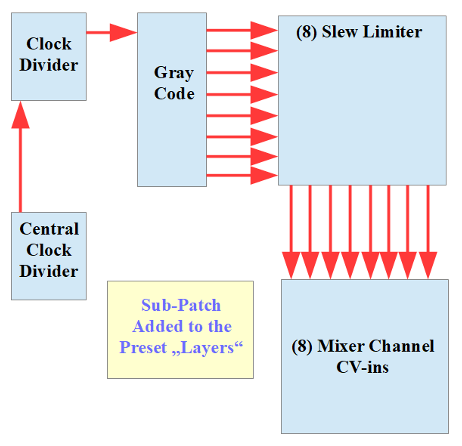
Thoughts on Generative Music - Part 11
(contains embedded video – there are VCV rack presets mentioned in the text here and there. Owners of my book, this article is an excerpt from, will get the link to those presets. More about my book here: https://www.dev.rofilm-media.net/node/331) If you want to support my work, please make use of the "PayPal" button - thank you very much indeed!
Chapter 3.4:
Certain Patch Techniques And Examples
We are approaching chapter 4 about building blocks of generative patching with this sub-chapter 3.4. But whereas in chapter 4 the more technical and organisational aspects prevail, I´d like to talk about a few patches of special musical and compositional meaning here in chapter 3.4 at first.
Chapter 3.4.1:
Switching Voices and Larger Parts of the Patch
When we have a couple of voices – different percussion instruments, VCOs etc. - we can switch between different combinations of them. If each of these voices is fed into an individual mixer channel, we can easily do so by (randomly) fading the channels in and out (or “hard switching” between them). This gives the whole piece a structure.

The preset “channelswitch.vcv” and the video behind the following link demonstrate an example. Based on the preset “layers.vcv” there´s a Gray Code module added (and a second clock divider to make the switches take place less often). The eight outputs of the Gray Code module switch different combinations of the 8 mixer channels on and off. Inserting slew limiters between the Gray Code module and the mixer channel CV leads to cross-fades instead of “hard switches”.https://youtu.be/qxOGreuQ5R0
We can use the same principle (with or without slew limiters) to switch larger parts of our patch on and off, parts, which are not voices, but parts of modulation networks. Instead of audio mixer channels we switch VCAs or CV mixer channels, which open and close the path to the sub-patches in question. In case we wanted only to switch a single sub-patch on and off we can use a Bernoulli module instead of a Gray Code module.
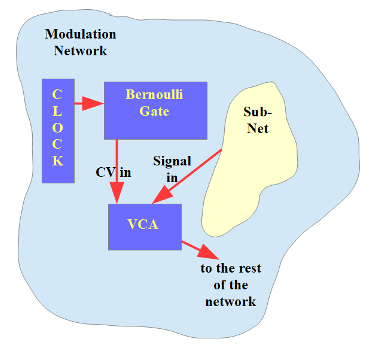
The preset “subnet.vcv” and the video behind the following link show an example.
Chapter 3.4.2:
Sculpture Randomness and Setting Borders
By feeding a Sample & Hold module with regular waveforms I can sculpture the random output of the S&H module down to no randomness at all. Instead of feeding in simple regular waves like sine, triangle, saw I can produce my own waves of course (using an LFO network or a cycled envelope or a more versatile LFO etc.). And so I can give the random voltages, which come out of the S&H module a kind of structure, which I can even emphasize by modulating the pulses, which trigger the Sample & Hold module. The preset “sculptureRandom.vcv” and the video behind the following link demonstrate this. https://youtu.be/hAhIS4FUGNQ
Sometimes I need the level of the random voltage to be quite precise between certain upper and lower borders. To achieve this I can patch a VCA (setting the upper border) and a CV offset module (setting the lower border) between the sample source and the S&H unit like shown in the following graphic. And there is an example of course: the preset “randomborder.vcv” and the video behind the following link. https://youtu.be/k0g20ma1utY
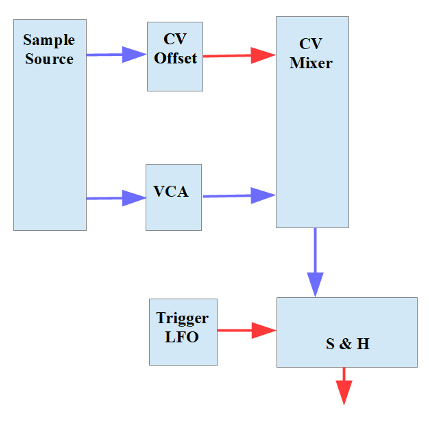
Chapter 3.4.3:
Jumping between certain BPM and Inverting Pitch Lines
There are dedicated BPM LFOs, and a lot (if not most) of the MIDI modules offer easy to handle BPM functionality, but there is also a rather basic way to adjust BPM and to jump between certain BPM rates.
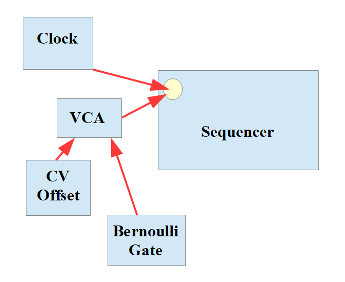
We can do the latter with a switch, e.g. a Bernoulli gate, and an CV offset module, the latter changing the CV input at a sequencer´s clock or at other clock generating units. To choose the right CV offset – what is: choosing the right clock frequency – we have to remember the following relation:
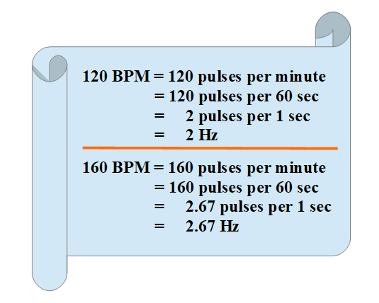
The presets “BPM.vcv” and “BPM2.vcv” as well as the video behind the following link demonstrate this technique. https://youtu.be/Nz29MZa7pF4
A small oscilloscope comes in handy when you want to do things like that. But even if you work exclusively with hardware systems, you can get some quite inexpensive ones. I use the one shown in the photograph. These little helpers come something around 80 dollars and offer a lot of useful functions, even if you don´t integrate them as an ordinary part of your system. But integrating these handheld oscilloscopes is not a difficult task. I have made a video about that matter. If you want to know more about it, just send me a message via my website https://dev.rofilm-media.net.
When we want to invert a pitch development, e.g. a melody line, a bass line or an arpeggio by simply using an inverter module, we have to be understand, that inverting this way means starting at the same note, but going into different directions. It will be necessary to offset one of the lines by 1 or two octaves most of the times. Just follow the 1 V/Oct characteristic to choose the right CV offset. The preset “invert.vcv” and the video behind the following link demonstrate this. https://youtu.be/ck7q31E2cwk
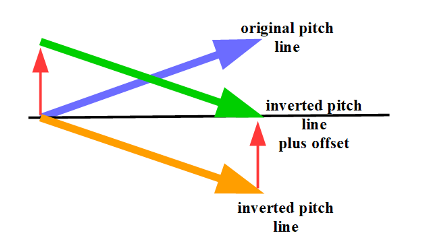
to be continued.
to part 1: https://www.dev.rofilm-media.net/node/335
to part 2: https://www.dev.rofilm-media.net/node/343
to part 3: https://www.dev.rofilm-media.net/node/344
to part 4: https://www.dev.rofilm-media.net/node/358
to part 5: https://www.dev.rofilm-media.net/node/365
to part 6: https://www.dev.rofilm-media.net/node/374
to part 7: https://www.dev.rofilm-media.net/node/381
to part 8: https://www.dev.rofilm-media.net/node/386
to part 9: https://www.dev.rofilm-media.net/node/391
to part 10: https://www.dev.rofilm-media.net/node/404
to part 12: https://www.dev.rofilm-media.net/node/415
to part 13: https://www.dev.rofilm-media.net/node/425
to part 14: https://www.dev.rofilm-media.net/node/427

Add new comment